|
By SGT. JOHN McDOWELL Roundup Field Correspondent
WANTING, CHINA, Jan. 28 - A three-year-long Japanese blockade of overland supply routes to the Chinese was broken this afternoon when the first convoy over the Ledo Road to the Burma Road crossed the Burma-China border and entered this war-shattered village, nestled among low, barren foothills.
Brig. Gen. Lewis A. Pick, builder of the Ledo Road lifeline to China, led the six-mile-long convoy of trucks, weapons carriers, jeeps and artillery onto Chinese soil, 16 days after leaving the railhead bazaar of Ledo, Assam, on the history-making mission.
Since leaving Namhkam, the convoy has followed close on the heels of advancing elements of the Chinese 38th Division, which was given the task of clearing the route between Namhkam and the juncture of the Ledo and Burma Roads at Mongyu, near the Chinese border.
Units of the Chinese Expeditionary Force, veterans of the Salween Campaign, simultaneously were mopping up pockets of Jap resistance on the Burma Road between this border village and Mongyu.
The convoy laid over at Namhkam for three days while final mopping up operations were being carried out. Yesterday, the Chinese 38th and the Chinese Expeditionary Force met at Mongyu. Following a tank assault against Jap artillery positions on the crest of hills above the village, it was announced that the road had been secured and the convoy could proceed toward its destination at Kunming.
All morning, the convoy passed through demolished native villages, crossing rolling terrain which only two days ago had been aflame with battle. Along the way, well-equipped American-trained Chinese troops grinned as they marched up the dusty road toward China, shouting Ding how to the convoy drivers.
Filing down from the China border were soldiers of the Chinese Expeditionary Force, dressed in tattered blue uniforms with sandals on their feet. They were a tired army, weary after a 10-month campaign across wild, mountainous terrain of the Salween River country. But they were a victorious army, cheerful and proud.
Wanting blazed with color this afternoon as ceremonies were held, dedicating the passage of the convoy into China. High officials - Chinese and American - were on hand to congratulate Brig. Gen. Lewis Pick. Among those present were Lt. Gen. Dan I. Sultan, Commanding General of the India-Burma Theater, Maj. Gen. Claire L. Chennault, of the 14th Air Force; Maj. Gen. Howard C. Davidson, of the 10th Air Force; Maj. Gen. Francis W.
|
Speaking from a bamboo stage on the floor of a tiny valley hemmed in by hills, charred and burning from incendiary bombing, and under the protection of constant air cover of the 10th Air Force, Pick told the crowd of notables, Chinese troops, American Engineers and convoy personnel:
"It gives me the deepest satisfaction to lead this first convoy over the Ledo Road into China. For the first time since the fall of Rangoon and the cutting off of the Burma Road, there is a land route open for overland transport of supplies from India to China.
"The opening of this new land route marks another milestone in the quickening march on Tokyo. I am confident that it will aid materially in speeding the defeat of our Japanese enemy."
Sultan told the gathering that the full credit for the opening of the China supply line must be given to the combined efforts of American, Chinese and British Infantrymen and the heroic performance of the American, Chinese and Indian Engineers under the command of Pick.
Without this coordination, he said, a highway never would have been blasted across the remote jungle lands of India and Burma to China.
Following the ceremony, the convoy pushed on up the Burma Road toward its first bivouac on China soil. Kunming and more ceremonies on a grander scale are 600 miles away. But this afternoon, in a dingy little Chinese town, little known to the outside world, a new land route to China has been opened.
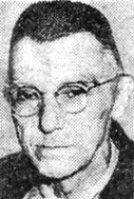
|
STILWELL'S JOB
GROUND FORCES
WASHINGTON - (ANS-UP) - Appointment of Gen. Joseph W. Stilwell as Commander of Army Ground Forces was announced this week by Secretary of War Henry L. Stimson.
Stilwell, former CBI Theater Commander, will succeed Lt. Gen. Ben Lear, who has been made Deputy Commander in ETO in charge of administrative matters concerning American troops.
A War Department spokesman announced, "The mission of the Army Ground Forces is to create and train combat units which, after training, are placed under a commander. Gen. Stilwell will command all the U.S. ground troops not yet in theaters of operation."
Uncle Joe also received a cablegram from Lt. Gen. Dan I. Sultan, India-Burma Theater Commander, expressing his regret that Stilwell was not present to see the opening of the new Ledo Road.
WANTING, CHINA - It is early in the afternoon and the date is January 28, 1945. The first India-China convoy has just now rolled from Burma into this little Chinese border town. The moment is historic, the enthusiasm boundless. Chinese soldiers who fought their way from Ledo across Japanese-held Burma to Wanting in China and Chinese soldiers who advanced to Wanting through the arduous Salween River campaign joined forces here only a few days ago. All their cheers and smiles and fluttering flags are meant for this first convoy which arrived after such an eventful journey.
A cavalcade of over 100 vehicles, loaded with supplies, followed a route which still had to be cleared of suicide squads the Japs left nesting in the hills. Their weapons were zeroed on the convoy's path. An exciting tank

|
The journey was an exciting series of disappointments and triumphs, which began to shower upon us during our eight days' bivouac in Myitkyina.
When we reached Namhkam, it looked to us much like Myitkyina and Bhamo in the days when the Japs cleared out. Once Namhkam was a busy little town on the old trading route to China. Marco Polo passed through here, they say. Actually, the Jap left Namhkam a week before our convoy rolled into it. The elaborate monastery of the Golden Eye in the center of the town is a heap of ruins. Yet, the wreck retained a pathetic splendor, curiously inviting to curious Americans. Stripped from their canopies and supporting pillars, monumental, gold-plated idols tower over the sea of rubble. A few still carry their attractive marble heads on their golden shoulders, but many lost theirs down into the decay some 15 feet below. The smaller gilded figures of minor deities, also beheaded and armless, are heaped around the large jewel-studded thrones like a phantom bodyguard which fell to the last man. The G.I.'s of the convoy surmounted the fallen walls. They climbed to the shining thrones and had their pictures taken in the lap of Buddha.
In fact, all buildings (Jap big-wigs usually headquarter in them) were bombed into rubble by the 10th Air Force. In the remaining skeletons of wooden houses of Namhkam, the tired but always smiling men of the Chinese First Army made the best of a well-deserved rest. As we moved into our next bivouac on the other end of the town, lonesome G.I.'s waved to us from porches of empty houses. They sat there like little rajahs, reading old American magazines.
Then a thunderbolt struck the bivouac. Around the village of Mongyu, 25 miles from the bivouac, heavy Japanese artillery was nesting in the hills. The Road was being shelled by 70 and 150 mm howitzers.
This is what happened. Retreating towards Lashio, the Japs left these isolated batteries in hiding. Their task obviously was to remain in the hills until the first convoy came through. The following day, Brig. Gen. Joe Cannon, NCAC Chief of Staff, arrived, conferred with Gens. George Sliney, Lewis Pick and Sun Li-jen, the commander of the Chinese First Army, immediately thereafter, the last battle for the Burma Road began and lasted three days. But during those three days Lt. Col. Gordon Seagrave, the Burma Surgeon, who just returned to his home in Namhkam, opened his gates to the people of the convoy, and we saw unfurled one of the most colorful spectacles North Burma has ever seen.
The hilltop base of the Burma Surgeon became, for three days, a Tower of Babel. The fabulous doctor's return was going to be celebrated the second night after our arrival in Namhkam. The Kachins from the hills and the various Shan tribes from distant valleys, where they kept in hiding while the Jap was here, poured in by the hundreds, wearing their ceremonial native costumes. The women wore all the jewelry they possessed on their bodies, while the men carried their beautiful dahs of bamboo, steel and silver. So they streamed in with live poultry in innumerable baskets, fresh eggs and rice, tokens for the legendary doctor who once healed them and returned. Special presents were brought to Seagrave's beautiful Burma nurses who were going to become the main actors of the great feast.
And now, readers, I must interrupt my story of the first India-to-China convoy. While I am writing these pages in the Chinese border town of Wanting, the dramatic celebration of the border crossing is taking place directly below my window. It is almost over now. Within 30 minutes, the copy of the correspondents will be flown by special plane to Myitkyina. From there, it will be wired to Delhi and cabled to the rest of the world.
Soon, our convoy will be rolling again. But I want to tell you about the great night on the Seagrave hill. I want to tell you of the last battle of the Burma Road. It was a tank battle. Your Roundup correspondent sat in the mobile command post from where the ground operations were directed. It was a breath-taking adventure and I don't want you to miss it. There may be time between now and Kunming. Later, I hope to give you the last battle with a detailed account of the rest of this great American Odyssey.
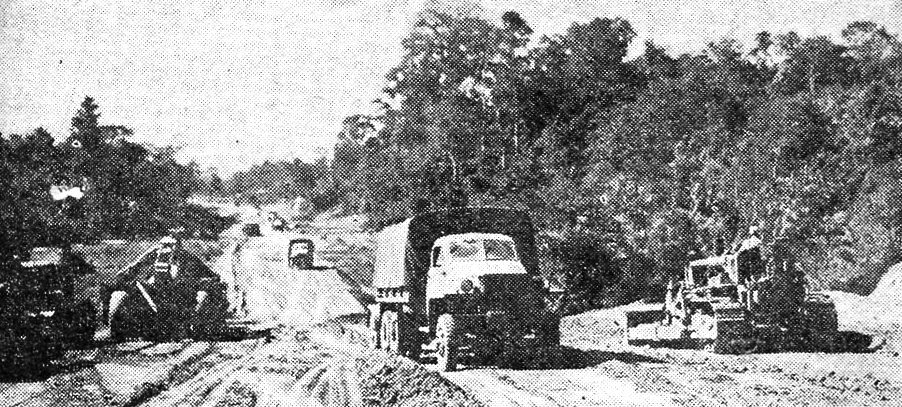 Bulldozers which slugged their way through the dreary monsoon are still at work on the Ledo Road as trucks of the
first convoy carrying war material to China hump and twist their way over the blockade-breaking artery.
Bulldozers which slugged their way through the dreary monsoon are still at work on the Ledo Road as trucks of the
first convoy carrying war material to China hump and twist their way over the blockade-breaking artery.
|
And Behind The Road, Pick
WANTING, Jan. 28 - This afternoon, a dusty jeep pulled slowly to a stop in this battle-ravaged village across the China-Burma border, and a tall, gray man with a big stick climbed out, looking back at the long convoy which stretched down the shell-piled road as far as the eye could see.
That moment was for Brigadier General Lewis A. Pick, the greatest event in his military career in the Corps. of Engineers, which began with his graduation from Virginia Polytechnic Institute in 1917. For, as the first of the big trucks towing artillery pieces crossed the border into Wanting on the Burma Road, the general officially opened

|
Ahead of the convoy, far beyond the purple haze of the Himalayas and the perpendicular gorges of the Salween, is Kunming. Ahead are the cheering multitudes, the feasting, the dragon dances through narrow streets and the ceremonies acknowledging the opening of the first land route to China since the fall of Rangoon and the severing of the Burma Road supply artery in 1942. Ahead are the speeches, the hand-shaking, the toasts and the pledges.
All that belongs to the world - a symbolic promise to the oppressed everywhere that deliverance is near. But this afternoon belongs to Pick and his hard-bitten Engineers who built a military highway through the roughest terrain in the world. It belongs to the legion of service troops which supported this engineering project. And, it belongs to the fighting men, American and Chinese, who pushed the Japs back from the path of the road so the bulldozers, the graders, the demolition men could forge ahead through the jungle.
Today in Wanting, Pick told those assembled on the China border, "The lion's share of the credit for the opening of this new route must go to the Chinese, American and British combat forces who have fought their way through the worst possible terrain to drive back the Jap invader. They have made possible the efforts of the Ledo Road Engineers who hacked the road over mountainous jungle terrain on the very heels of the combat forces. For more than two years, our Engineers - American with the help of Chinese and Indian - proceeded to carve out their road, and they, too, must be given only the highest praise."
As the General spoke, he seemed weary, but proud. For many months, his has been the responsibility for the greatest engineering project ever undertaken by the Corps. of Engineers in wartime. His decisions have determined the course of the Ledo Road through treacherous mountains, jungles and swamp lands where a mistake in plotting the route could easily have meant disastrous loss of precious time and equipment.
Pick is a soft-spoken southerner with a mild manner and an easy smile. But, behind his seemingly slow, studious approach is a hard-headed business sense and an ability for organization and getting things done.
It was this reputation which resulted in his being relieved of his job as division engineer of the Missouri Valley flood control project in 1943 and the subsequent assignment as commanding officer of the Ledo Road project.
This job was a tough one - a "hot potato" - which threatened to burn anyone's fingers who touched it. The road had been started in December of 1942, and when Pick assumed command on October 13, 1943, progress seemed hopelessly stalled in the maze of densely-jungled precipitous mountains.
The General's first act was to move Road Headquarters up to the point. Next he instituted a round-the-clock working schedule. When he was told that there was no light for working nights, he rounded-up all the available lighting equipment on the base and shipped it forward. When this proved inadequate, he inaugurated a method of burning flares in buckets of oil - a system which is still widely used for night work along the road.
|
Pick moved up to Road Headquarters when General Joseph W. Stilwell paid his first visit. They met in a rain-soaked tent which served as Pick's jungle office. "Where are your detail maps?" Stilwell asked. "I have none," Pick said. "Where are your progress charts?" "I have none." "Where is the point of the road now?" Pick took a small scale map and marked a point in the shaded Patkai mountain sector. "Here at the 50 mile mark," he said.
Stilwell studied the map for a moment, then asked "When can you build me a jeep road to Shingbwiyang?" "I can't build you a jeep road," Pick answered, "but I'll build you a military highway to handle truck traffic."
"And when can you get that road through here to Shingbwiyang?" "When do you want it," Pick countered. "Can you get it through by the first of January?" Stilwell asked. Pick said "Okay."
Then Stilwell and Pick hiked up to the point. They labored through knee-deep mud, passing dozers stalled in the mud up to the stacks. When they returned, Stilwell turned to Pick and asked, "When did you say you'd get the road through to Shingbwiyang?" "By the first of the year," Pick answered.
That first meeting took place November 31, 1943. On the morning of December 27, 1943, the lead dozer broke the tap at Shingbwiyang in Burma's Hukawng Valley, and the engineers had conquered the Patkais four days ahead of schedule. A convoy of 55 trucks carried the first combat troops brought into North Burma by vehicle.
The General has managed to transplant his driving determination to get the job done in all the outfits serving under him. He has done this mainly through long hours in the field with the men.
During the anxious months of the monsoon, Pick spent most of his time in the forward areas where his engineers were battling the elements. His office at Ledo was seldom occupied. He was at the front where forward elements of his engineer units were working under sniper and artillery fire and bombing and strafing attacks.
All that is in the past - milestones of the Ledo Road project. Today, as the General looked over the trucks he has brought 478 miles over the road he has built from Assam, India, to the Burma Road, he probably envisioned the long lines of supplies which will follow over to the Chinese in the days to come.
|
PURPLE - HEARTED
JAPANESE RAIDERS NICK PIN-UP
ADVANCED ASC BASE, BURMA - War is hell, chum, when your choicest pin-up gal gets shot up.
A recent Zero raid chased Mechanicommando Pvt. Thomas F. Ezell into his foxhole. When, finally, this citizen serving with Col. Marvin Sledge's "Burma Peacocks," was able to emerge from his haven of safety, he was desolate to discover that his orchidaceous Varga blonde with the red-flowered bathing suit had been clipped in the left shoulder by an anti-personnel fragment.
With filling solemnity, Ezell drew an unofficial Purple Heart on the honey-blonde's left upper, well, clothing, if you must be delicate, and moved her to the No. 1 place of honor in the gallery of morale builders deep down there in the Burma teak and palm.
Uncle Joe Says To General Dan:
Speaking over the NBC Army Hour, Gen. Joseph W. Stilwell, newly-appointed commander of Army Ground Forces, replied to a message sent him by Lt. Gen. Dan I. Sultan that "your (Stilwell's) leadership and indomitable will have made possible the Ledo Road. Of all people, you should be here to witness the result of your efforts."
Stilwell answered, "I take off my hat to the men who fought for it and built it." These men, he said, "never saw the Taj Mahal or called on a maharajah," but "saw only the soggy jungles through which they had to cut their way foot by foot to do a job many people thought was impossible.
"When you look at a map of the world, the drive from Ledo to Myitkyina to the Salween seems short. To the soldiers, it is the longest road in the world."
Sultan messaged Uncle Joe, "It is a matter of sincere regret to every member of the India-Burma Theater that time and space have made it impossible for you to be present. I know you will be present with us in spirit."
|
Wedemeyer Up For Third Star
Roundup Staff Article
Nomination of Brig. Gen. Vernon G. Evans, India-Burma Theater Chief of Staff, to the rank of major general and the nomination of four colonels for their first stars accompanied a list of 103 promotions sent to the Senate for confirmation this week.
Other nominations included promotion of Maj. Gen. A. C. Wedemeyer, China Theater Commander, to lieutenant general.
Colonels in the I-B Theater nominated to the rank of brigadier general are Clarence C. Fenn, Judge Advocate; Gene Hall, Chief of Staff, SOS; Edward C. Rose, Commanding Officer, Transportation Service, SOS; and Frank D. Hackett, Bengal Air Depot Commander.
Among the names sent to the Senate for confirmation was that of Elliott Roosevelt, second son of the President, Air Force colonel commanding the 325th Aerial Photographic Reconnaissance Wing in Europe. At 34,
|
To your new Theater newspaper, our sincere best wishes. To those in China who have supplied us with material and helpful criticism, our heartfelt gratitude. |
Maj. Gen. Leonard T. Gerow, Fifth Army Corps Commander, has been nominated to be lieutenant general and Brig. Gen. Anthony C. McAuliffe, Deputy Commander of the 101st Airborne Division, to major general.
MERCY PLANES FOR MARSMEN
GEN. SULTAN'S HQ., NORTH BURMA - Tiny L-5 liaison planes ... deep in the jungle hard by positions of the American troops of Brig. Gen. John P. Willey, 30 miles below Mongyu, junction of the Ledo-Burma Roads.
American aircraft are landing and taking off from a shell-marked field near the road block that is ranged in by Japanese artillery and mortar fire.
Lt. Benjamin O. Putnam landed first in a test flight, but his plane was destroyed by a Jap shell on the take-off. A second plane crashed on the field, but Putnam got off on the third plane.
The operations of the liaison mercy planes are under command of Capt. Gari King.
|
Grew Asks China
WASHINGTON - (ANS) - Acting Secretary of State Joseph C. Grew this week virtually called for an agreement between the Chiang Kai-shek Chungking Government and the North China Communists, reported the Associated Press after a press conference held this week by Grew.
The United Press, on the other hand, termed Grew's statement as a "gentle hint to the Chinese to increase their efforts to settle their internal differences."
Grew's statement follows:
"The Department has received no information from the Embassy at Chungking of a Kuomintang-Chinese agreement. It would be very gratifying to us to learn of a consummation of such an agreement.
"We earnestly desire the development of a strong and united China. To that end, this Government has been lending its best efforts to be of service in appropriate ways, such as through the exercise of friendly good offices when requested by the Chinese, through direct military assistance in the prosecution of the war against Japan and through assisting China's economy to survive the strain of war."
Grew's statement comes after many months of American efforts to get Chiang and the Communists to agree upon a formula for co-operation, United Press adds.
During the period, U.S. Ambassador to China, Maj. Gen. Patrick J. Hurley made a trip into Northern China to visit the capital of the Communists.
CLOSE, BUT NO CIGAR
BURMA - A number of Army Airway Communications System men at this airfield broke a habit just in time. They had been accustomed to gathering regularly at a tent boasting a radio for their evening bull sessions. One evening recently, they arrived at the tent only to find that the radio had been moved. S/Sgt. Bill Latz reports that they uttered the usual gripes, and wandered off.
Shortly thereafter, just as they ordinarily would have been settling down to soft music, Jap planes came over. They dropped a string of anti-personnel bombs, one of which inconsiderately turned the tent into a ragged brown sieve. The night before, it would have meant a half dozen AACS casualties. - By Sgt. WILL CHASAN.
UNIQUE ATC TRANSITIONAL SCHOOL
|
CENTRAL INDIA - To fly the ATC's famed Hump Route, where the great rocky fingers of the Himalayas stretch menacingly skyward, pilots must be better than average. Because of this, a school, the only one of its kind in the world, has been established at this air base.
On paper, the mission of the school is transition training. The difference from the ordinary is this: The flier who finishes the course has become a Hump pilot, having received instruction in a highly-specialized job.
The C.O. here is Lt. Col. Lee L. Willey, former airlines pilot with 14,000 logged hours. Of the mission of the school, he says: "We are life insurance salesmen. Every instructor at this field - and they're the cream of former Hump pilots - realizes the value of the information and know-how he is passing on to the man who sits in the cockpit beside him. He knows that the very training he is giving may some day save that man's life."
Last Spring, there was no consistency in flights from the various ATC bases in the Brahmaputra Valley. The rush of war disrupted any form of standardization. Planes flying from the various fields carried loads to China at different levels. Some bases did all their flying by day; others also flew at night. Some took to the air in heavy weather, others grounded their ships. There was a difference of opinion as to the proper load safe to carry. There was a wide disagreement over the necessary qualifications on instruments for Hump flying.
With all these problems confronting the school, chief pilots were called in from each of the Hump stations, and when the various angles were worked out, the entire group was put through a standardization course. Then they were sent back to impart their information to the other fliers at their bases.
Then problems native to India began to jam the works. Paramount was the impossibility of using gasoline at individual bases for transition when fuel was so desperately needed for regular cargo runs. Added to this was the difficulty of securing planes and personnel for flights.
A transition center to where all prospective first pilots could be trained seemed the solution. Thus, in September, the school was opened here. Only men who had actually flown The Hump and knew its dangers were to be trained. At least 100 hours of co-pilot time were mandatory before admittance.
Does the system work? Here are the facts. The fliers are put through one of the most strenuous courses ever conceived. During their week and a half here they are studying, learning, asking questions, every waking minute. So concentrated is the course that the school is able to turn out pilots in less than one-third the time required by most transition schools in the United States.
They are taught emergency procedure - the know-how which saves lives when something goes wrong with the ship. They are given an advanced course in radio and brush-up course in weather. They are given a special review on navigation. Weight and balance of cargo in the Commando and Liberator Express type planes is taught.
They learn air traffic control, and medical officers stress the proper usage of oxygen at high altitudes. And more than any other one thing, they spend hour upon hour at the controls of the type ship which they are learning to fly.
Each month more and more fliers finish their time on The Hump and under rotation plan are sent back to the States. This tremendous hole in the ATC system must be kept plugged by supplying a constant stream of first pilots to the various bases. To do this and yet at the same time maintain the efficiency of delivery is constantly making the transition school a more valuable asset to ATC's India-China Division.
LETTER TO THE EDITOR
GEN. GODFREY OFFERS TO EXPLAIN
Following an article by Field Correspondent S/Sgt. Edgar Laytha in the Dec. 14 issue of the Roundup, we have been more than slightly confoozed reading the various explanations offered concerning the functions of Airborne as compared with Aviation Engineers. Today, we reproduce what should be the final word in the form of a letter recently received from Brig. Gen. S. C. Godfrey, India-Burma Theater Air Engineer, which we believe is self-explanatory and should clarify the subject - The Editor.
Dear Sir:
In your issue of Jan. 4, I note that correspondent Laytha is taken to task for confusing Aviation Engineers with Airborne Engineers in a previous article in the Roundup. Perhaps a word of explanation will be enlightening.
"Aviation Engineers" is the general term of all engineers organized and trained as a part of the Army Air Forces, with the mission to build airfields in a hurry. "Airborne Aviation Engineers" are Aviation Engineers especially equipped with light bulldozers and other plant capable of being transported, "as is," in a C-47 or glider. They are trained to load and use this equipment on airborne missions where speed is paramount, and where the earth-moving task is not too formidable.
In practice, there is not much difference between the two types of units - at least in this Theater. Airborne Engineers are trained to use heavy as well as light equipment, and the Airborne unit that carved out airstrips overnight for Cochran's Commandos last Spring, as well as the Airborne unit that arrived at Myitkyina airfield the day of its capture and opened the field under new management - are both working most effectively now with standard heavy equipment. On the other hand, all the standard Aviation Engineer Battalions with their heavy equipment that are assigned to the 10th Air Force have had to disassemble that equipment, load it in over 1,000 plane-loads and reassemble it up in front. They can rightly claim to be Airborne Engineers themselves, and they have attained a mobility almost comparable to that of the Airborne units so designated. Col. Asensio, Engineer of the 10th Air Force, has both types of units under his command, and he could never have met the heavy demands for forward airfields so successfully without the use of the heavy standard equipment.
So when an Airborne Engineer outfit turns to standard heavy tools, and a standard Aviation Engineer Battalion takes apart its big bulldozers and goes to a new airfield job by air - there is plenty of excuse for correspondent Laytha to get the two mixed up.
In any event, anyone who has visited North Burma and certain parts of India will agree that there is plenty of credit to be handed out to all Aviation Engineers - not omitting those units which have been attached to the SOS for work on the Ledo Road and airfields in rear areas.
Sincerely, S. C. Godfrey, Brig. Gen., U.S.A., Air Engineer, I-BT.
|
Yanks of a Signal Aviation unit of the 10th Air Force in North Burma are fightin' mad, they inform the Roundup in no uncertain terms, claiming the "wild pig" adopted by Pfc. Guy Tedesco is theirs and theirs alone.
Shortly after celebration of the recent holidays, they tell us, the outfit's mascot went AWOL. In the Jan. 18 issue of the Roundup, the awful truth was discovered, they insist, writing: "Under the heading, 'Anything Can Happen In Burma,' you published a story that proved it could."
Several months ago in Assam, they claim Pfc. Homer Brown found, adopted, raised and loved a wild pig with a white spot on its forehead. The company rewarded his kindness by dubbing the then 10 pounds of walking pork as "Homer." Thus began the Legend of Homer the Pig.
"Homer" was a lady, but inconsistencies were disregarded. She was a particular pig. Bread crusts were not for her. And she demanded affection. Chewing trouser legs until she was noticed, she would roll over on her back and squeal in ecstatic delight while a G.I. shoe was rubbed the full length of her pinkish belly.
"Homer" became the first pig (alive) to ride as a passenger on an Army transport plane. She flew into Burma with her G.I. friends, putting pound upon pound and finally losing her girlish figure.
Then, O/A the first of January, holiday spirits in the outfit received a dampening blow. "Homer" didn't show up for her daily feeding.
A long and fruitless search resulted only in a series of disappointments. The few small clues were false alarms.
Thanks to the Roundup, however, "Homer" has finally been located, the unit claims, through its spokesman, Lt. William W. Hughes.
The lieutenant has enclosed a picture showing "Homer" cradled in the arms of Pvt. Kermit Hallemeir.
"Please note," asks Hughes, "the striking resemblance to the picture of the 'wild pig' posed with Pfc Guy Tedesco, of this vicinity, in your article. He has, without malice aforethought, abducted our "Homer."
The lieutenant says the G.I.'s of his outfit hope to contact Tedesco soon.
"Meanwhile," they beg of him, "discard all yearnings for a roast pig dinner," warning, "Murder, on top of pig-napping, is a serious crime."
 OF SUPER-FORTRESS
OF SUPER-FORTRESS
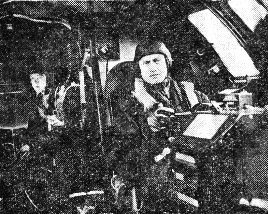 One of the first interior views of the B-29 Super-Fort to be released, this photo shows the pilot and flight
engineer at their posts in the huge ship. Many of the instrument panels which face the pilot on smaller bombers
are behind him in the space occupied by the flight engineer.
One of the first interior views of the B-29 Super-Fort to be released, this photo shows the pilot and flight
engineer at their posts in the huge ship. Many of the instrument panels which face the pilot on smaller bombers
are behind him in the space occupied by the flight engineer.
|
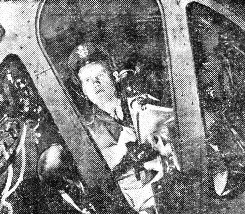 The bombardier sits amidst his delicate precision instruments. Note the flak-proof glass nose through which
he observes the target. The Super-Fort has unusually steady flight performance to aid the bombardier in attaining
accuracy in scoring bullseyes.
The bombardier sits amidst his delicate precision instruments. Note the flak-proof glass nose through which
he observes the target. The Super-Fort has unusually steady flight performance to aid the bombardier in attaining
accuracy in scoring bullseyes.
|
 Inside of the B-29 is divided into five sections, three pressurized. One of the pressurized sections is this
crew compartment, located just aft of the gunners sections in the center of the plane, where bunks are provided
for rest and relaxation of relief crews on the long mission.
Inside of the B-29 is divided into five sections, three pressurized. One of the pressurized sections is this
crew compartment, located just aft of the gunners sections in the center of the plane, where bunks are provided
for rest and relaxation of relief crews on the long mission.
|
ORIENTATION WITH NEW FLAVOR
APO 487 (Dinjan, India) - Enlisted men of Capt. James V. McGettrick's Service Squadron at this base look forward to his unique Orientation classes.
It still comes under the heading of Orientation, but a class conducted in the form of an entertaining quiz program, styled after such radio shows as Information, Please, Take-It-Or-Leave-It, and Kay Kyser's College of Musical Knowledge, is meeting with the approval of the G.I.'s.
Searching for new methods of presentation, the squadron last week received assistance from British Capt. A. T. C. Bone, resident of India for 15 years, who spoke on the "Indian Soldier." He brought with him four Indian soldiers, who he explained were Gurkha, Punjabi, Madrasi and Sikh fighting men. They were used to illustrate the captain's topic of discussion.
Future Orientation hours will bring as speaker: a Sikh Army major, a Brahman schoolteacher, and a British Army private.
Over 120 prizes of cigarettes and candy, furnished by the Squadron EM Club, were distributed to members of the audience this week who answered correctly questions asked by Pfc. Howard C. Jones on current events, American history, geography, sports, music, literature, etc. - By Sgt. CLARENCE GORDON.
MONEY TO CHINA
$210,000,000
WASHINGTON - (ANS) - The treasury announced completion of transfer of $210,000,000 to China in settlement for "advances of local currency" and for supplies, services and military construction furnished the United States in China.
It excluded certain reciprocal aid furnished to the U.S. by China, which Secretary Morgenthau described as Reverse Lend-Lease, including food and shelter for American forces in China.
Final payment was in the form of a check for about $150,000,000 given last week by Morgenthau to Dr. H. H. Kung, fiscal representative of the Chinese Government now visiting the United States.
The Treasury explained that some of the settlement came from U.S. funds already in China and part from funds previously placed to China's credit in the U.S.
WOMAN'S PREROGATIVE?
MIRRORS PROVE BOON TO HUMP JUMPERS
CALCUTTA - So you believe it's the exclusive prerogative of the gentler sex to carry mirrors?
Read on, friend, and be differently informed.
Emergency signaling mirrors are now to be made standard equipment in jungle kits for the use of personnel regularly flying The Hump for the India-China Division, ATC.
Tried and found extremely effective elsewhere, the mirror is expected to prove of special value in The Hump territory, where smoke signals are negated because of the innumerable fires kept alive, day and night, by hill folk.
The mirror is far superior than the code panels now in use as a means of initially attracting attention, although admittedly not able to express specific needs. Its maximum range is 10 miles.
The present model, about four inches by five, has an aperture through which a cross-shaped beam of light penetrates, and part of the reverse side is another mirror surface. When a passing aircraft is sighted through the cross and the small mirror shows the cross-shaped beam reflected by the hand or clothing and coinciding with the aperture, then the large glass is directed halfway between sun and airplane, and its powerful beam is aimed directly at the plane.
EAC
GROUND SUPPORT THIS WEEK
Roundup Staff Article
Eastern Air Command aircraft have been active in ground support the last two weeks, supporting opening of the Ledo Road, advance of the 14th Army on Mandalay and amphibious landings off Burma's west coast.
Fighter-bombers and liaison planes of the 10th Air Force came in for high praise from Maj. Gen. Francis W. Festing, commander of the 36th British Division, NCAC. festing, in a wire to Maj. Gen. Howard C. Davidson, commanding the 10th, said in referring to the capture of Mabein and Lawa, "Had it not been for the 10th USAAF fighter-bombers, we would have suffered heavy losses and might not have been able to take the positions. The unarmed liaison planes also were wonderful and all ranks are grateful."
Strong air cover was given the advance along the Ledo Road as the first convoy moved into China.
EAC has also made the Mandalay-Rangoon Railway untenable to the Japs as far as daylight traffic is concerned. The 386-mile rail line linking Mandalay with the supply base of Rangoon is now only used under cover of darkness. B-25's of EAC found the Nips running trains at nights this week and destroyed five locomotives, damaged five others.
Mandalay area was also hit by Liberators of EAC. Amapura was the chief target but troop concentrations were also attacked to support the advance of 14th Army units.
The landing of the Royal Marines on the island of Cheduba was given strong air cover. This followed the pattern set at Akyab, Ramree, the Mylebon and Kangaw.
The XX Bomber Command was also active this week, India-based B-29's hitting Indo-China.
 Chinese troops fighting in Burma and those of the Chinese Expeditionary Force battling on the Salween Front
joined forces this week somewhere between Wanting and Namhkam. In the left picture, Gen. W. Wong, left, an Army
commander in the CEF, and Lt. Gen. Sun Li-jen, commander of the Chinese First Army in Burma, shake hands to
symbolize the meeting of their forces. In the right picture, a similar observance is held between American liaison
officers Lt. Col. Robert P. Thompson, left, serving with the Chinese 38th Division in Burma, and Col. B. L. Malcolm,
of the CEF.
Chinese troops fighting in Burma and those of the Chinese Expeditionary Force battling on the Salween Front
joined forces this week somewhere between Wanting and Namhkam. In the left picture, Gen. W. Wong, left, an Army
commander in the CEF, and Lt. Gen. Sun Li-jen, commander of the Chinese First Army in Burma, shake hands to
symbolize the meeting of their forces. In the right picture, a similar observance is held between American liaison
officers Lt. Col. Robert P. Thompson, left, serving with the Chinese 38th Division in Burma, and Col. B. L. Malcolm,
of the CEF.
|
Jap Army On Move
Roundup Staff Article
Japanese armies in China renewed their drive against the Hankow-Canton Railroad this week and were attempting to close a gap between Hengyang and Canton, still held by the Chinese.
The Japs were advancing from the north and the south. Another column was hitting from the west. Yingtak, in Kwangtung Province, had fallen to the enemy, and the Japs were fighting in the suburbs of Kukong, provisional capital of the province.
A second string of 14th Air Force fields along the railroad, hitherto on the secret list, were disclosed as other objects of the Jap drive. These USAAF bases are endangered as the Japs drive forward.
Maj. Gen. A. C. Wedemeyer, China Theater commander of U.S. Forces, said the Americans had achieved air supremacy in China, adding the air position has been "greatly enhanced by air blows from the Pacific."
It was also announced that a new Chinese Combat Command of the U.S. Forces is being installed in all combat areas to advise the Chinese. Maj. Gen. Robert McClure, former Chief of Staff to Wedemeyer, will command this group. Brig. Gen. Mervin Gross will act as Wedemeyer's Chief of Staff.
SURPRISE 14TH ATTACK BAGS 40 JAP PLANES
14TH AIR FORCE HQ., CHINA - In a single surprise raid on Peiping airdrome this week, 14th Air Force fighters and bombers destroyed 40 Japanese planes, bringing the January total to more than 305 enemy aircraft knocked out.
In addition to the Peiping attack, three other Jap planes were downed over Nanking airfield during an attack on harbor shipping in which one large vessel was sunk and several damaged. Numerous enemy aircraft were damaged in this and other areas.
It was also a particularly bad week for Nip railroads and locomotives, with Maj. Gen. C. L. Chennault's fliers making frequent attacks on these targets despite inclement flying weather. Approximately 100 locomotives and numerous cars were destroyed during the week in raids on yards and tracks at Sinsiang, Hankow, Peiping, Kaifeng and surrounding sectors. A large troop train near Kweiyi was also destroyed.
Nine bridges in Burma were reported knocked out and repeated strafing and bombing attacks, especially in the Wanting-Mongyu area, were delivered in direct support to Allied ground troops.
From all missions, 10 U.S. planes were reported lost.
U.S. POPULATION AT 138,100,874
WASHINGTON - (ANS) - Population of the United States, including the Armed Forces overseas, was 138,100,874 as of last July, with women outnumbering men by 6,000 for the first time in the nation's history, the Census Bureau reported this week.
There were more than 13,000,000 births since the last census, the Bureau said, but this was offset by about 7,000,000 deaths, including military casualties. Immigration accounted for a 400,000 gain in the total since 1940.
Mandalay Drive Aided By Cover From Aircraft
Roundup Staff Article
British 14th Army troops advanced slowly towards Mandalay this week in the steps of complete air cover; and Royal Marines made the fifth British amphibious landing at Cheduba Island, off the west coast of Burma.
Ondaw has fallen to the 14th Army, bringing the main British forces within 15 miles of Mandalay. The Japs flung strong counter-attacks against the British bridgeheads across the Irrawaddy, but the drives were repulsed.
Light resistance was reported by the Marines on Cheduba. On Ramree, invaded by troops of the 15th Indian Corps last week in another amphibious operations, the 26th Indian Division had penetrated to the half-way mark on the island. The Japs have made no firm stand and were attempting to delay operations by mines and booby traps.
Other troops of the 15th Corps occupied Myohaung, northern terminus of the Myohaung-Taungip escape artery for enemy troops hemmed in by the British leap-frog landings on Akyab, Maybeon, Myebon, Ramree, Cheduba and on the mainland near Kangaw.
|
WASHINGTON - (UP-ANS) - The White House revealed this week that Donald Nelson reported to the President that China, aided by American experts, has co-ordinated her war efforts, and is "throwing its weight into the job of winning the war."
Only portions of the report were made public by the White House, which said some sections could not be released "until such time as the military situation permits."
Nelson said that when he first reached China in September, he was disturbed by the "relative lack of constructive war effort," but that since then the situation has been "largely corrected."
Of his November talks with Chinese leaders, he said, "post-war questions were put aside by mutual agreement," but his report proposed, however, that the United States aid China in the post-war era on a realistic and "sound business basis."
Nelson foresaw "changes and genuine cooperation" between the Chungking Government and the Chinese Communists and said three factors - appointment of Maj. Gen. A. C. Wedemeyer, Ambassador Maj. Gen. Patrick J. Hurley and the arrival in China of the American War Production Mission - had led to seven specific "significant measures" to tighten up the Chinese war effort.
(1) "Advance steps taken to check the Japanese advance"; (2) Chinese WAr Production Board establishment, functioning with American advisory deputies; (3) Work begun by the American technical production mission, including five steel production experts, one alcohol production specialist; (4) Financing of war production requirements, with four Chinese Government banks contracting to lend 10 billion dollars in Chinese cuurency to the Chinese WPB for financing essential production; (5) Allocation of additional transportation facilities to China; (6) Chinese Cabinet shifts made to strengthen the war effort; (7) "Moves made to bolster Chinese civilian morale. Feeling China's economy is being strengthened and that the country's productive ability is growing will do more than any amount of propaganda to raise the morale of the Chinese people."
Nelson informed the President that China's war production this spring should be at least double the November rate "and soon will be felt on the fighting front."
Marauder Chaplain Wins Bronze Star
10TH AIR FORCE HQ., BURMA - Capt. Oren T. V. Chamberlain, 10th Air Force Chaplain, has been awarded the Bronze Star Medal by Maj. Gen. Howard C. Davidson, Commanding General of the 10th Air Force.
The award was for his outstanding devotion to duty during the battle of Myitkyina. For a month he was the only American Chaplain stationed in Myitkyina. During the battle he held 79 services attended by more than 2,000 men.
The Chaplain paid 126 visits to three hospitals, seeing 2,600 patients. He collected and censored more than 3,000 letters and many of them were last letters written by soldiers whose names are now carved on the "roll of honor." During one hospital visit, he was wounded and received the Purple Heart. He was often under fire.
INDIA DHOBI-WALLAHS RAPPED
ATC pilots interviewed at Miami, Fla., this week put in a harsh word for India, according to Army News Service.
Crews announced they prefer to fly the "clothesline" from Miami to Brazil or British Guiana because they are able to get overnight laundry service at prices far below U.S. standards.
India, however, is "pretty tough" on shirts and other laundry, the ATC pilots explained, because the customary method in India is to beat the garments against rocks instead of vigorous washing with soap.
ATC crews said that Acera on the African Gold Coast was really their favorite place to get laundry done. At Acera, they say, native men have as many wives as they can afford and the more American fliers' laundry their wives take in the more wives they're able to purchase.
|
It was old home week for M/Sgt. Earl H. Gilliam, who recently reported for duty with the Seventh Bomb Group. Gilliam, first man to alight from a truckload of replacements, was a member of Seventh Bomb when it left Uncle Sugar in 1941, Philippines-bound. The Pearl Harbor attack shifted the Seventh's APO to Australia and later Java. Shortly after the fall of Java, Gilliam rotated home.
|
STRICTLY G.I. By Ehret 
|
The C.B.I. Roundup is a weekly newspaper of the United States Forces, published by and for the men in China, Burma and India, from news and pictures supplied by staff members, soldier correspondents, United Press, OWI, and Army News Service. The Roundup is published Thursday of each week and is printed by The Statesman in New Delhi and Calcutta, India. Editorial matter should be sent directly to Capt. Floyd Walter, Hq., U.S.F., I.B.T., New Delhi, India, and should arrive not later than Sunday in order to be included in that week's issue. Pictures must arrive by Saturday and must be negatives or enlargements. Stories should contain full name and organization of sender. Complaints about circulation should be sent directly to Lt. S.R. Rose, Hq., U.S.F., I.B.T., New Delhi, India. Units on the mailing list should make notification of any major change in personnel strength or any change of APO.

|
FEBRUARY 1, 1945
Adapted from the original issue of I.B.T. Roundup shared by Greg Clark
Note: This was the first issue to carry the masthead: India-Burma Theater Roundup
Copyright © 2007 Carl Warren Weidenburner
THE CHINA LANTERN
TOP OF PAGE PRINT THIS PAGE ABOUT THIS PAGE SEND COMMENTS
PREVIOUS ISSUE CLOSE THIS WINDOW NEXT ISSUE
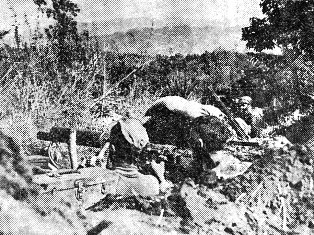 Dug in on a ridge controlling a curve in the Burma Road, Yank Infantrymen of the Mars Task Force block the enemy
escape route after a forced march over the mountainous jungle in a flanking movement that trapped the Japs to the
north in the Wanting-Namhkam area.
Dug in on a ridge controlling a curve in the Burma Road, Yank Infantrymen of the Mars Task Force block the enemy
escape route after a forced march over the mountainous jungle in a flanking movement that trapped the Japs to the
north in the Wanting-Namhkam area.
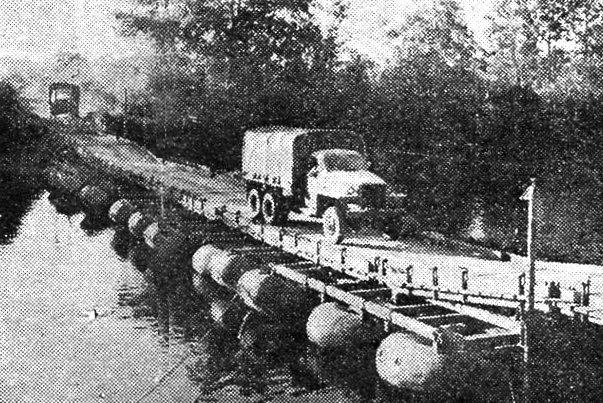 Over a bridge of floating rubber pontons, trucks in the initial convoy to China complete the first lap of the
journey from Ledo to Myitkyina.
Over a bridge of floating rubber pontons, trucks in the initial convoy to China complete the first lap of the
journey from Ledo to Myitkyina.
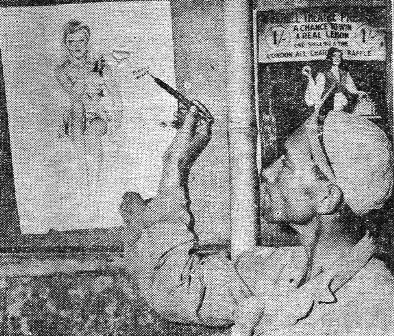
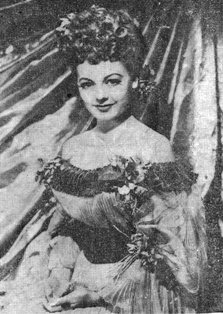 Lovely Wanda McKay once squandered her time as a TWA hostess. Now she's in the flickers and posing for
cheesecake photos as the one with which Roundup soothes your tired eyes today.
Lovely Wanda McKay once squandered her time as a TWA hostess. Now she's in the flickers and posing for
cheesecake photos as the one with which Roundup soothes your tired eyes today.
 The Men of Mars and a K-9 dog cross a bamboo footbridge as they assemble to attack a Jap position near the
Burma Road below the Wanting-Namhkam area.
The Men of Mars and a K-9 dog cross a bamboo footbridge as they assemble to attack a Jap position near the
Burma Road below the Wanting-Namhkam area.
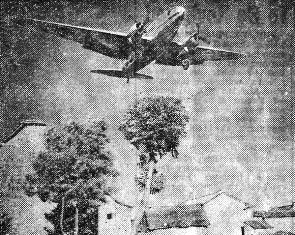 Flaps down, a C-46 approaches the landing strip at the ATC Transition School.
Flaps down, a C-46 approaches the landing strip at the ATC Transition School.
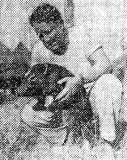
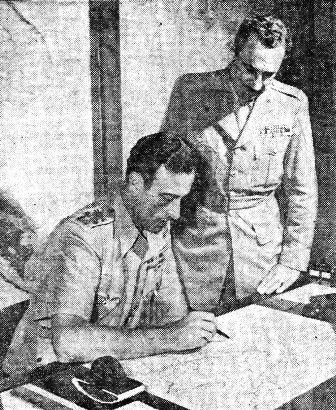 Adm. Lord Louis Mountbatten, Supreme Commander, SEAC, goes over a problem with his deputy, Lt. Gen. Raymond
Wheeler, right, who will shortly make a tour of Allied installations.
Adm. Lord Louis Mountbatten, Supreme Commander, SEAC, goes over a problem with his deputy, Lt. Gen. Raymond
Wheeler, right, who will shortly make a tour of Allied installations.
